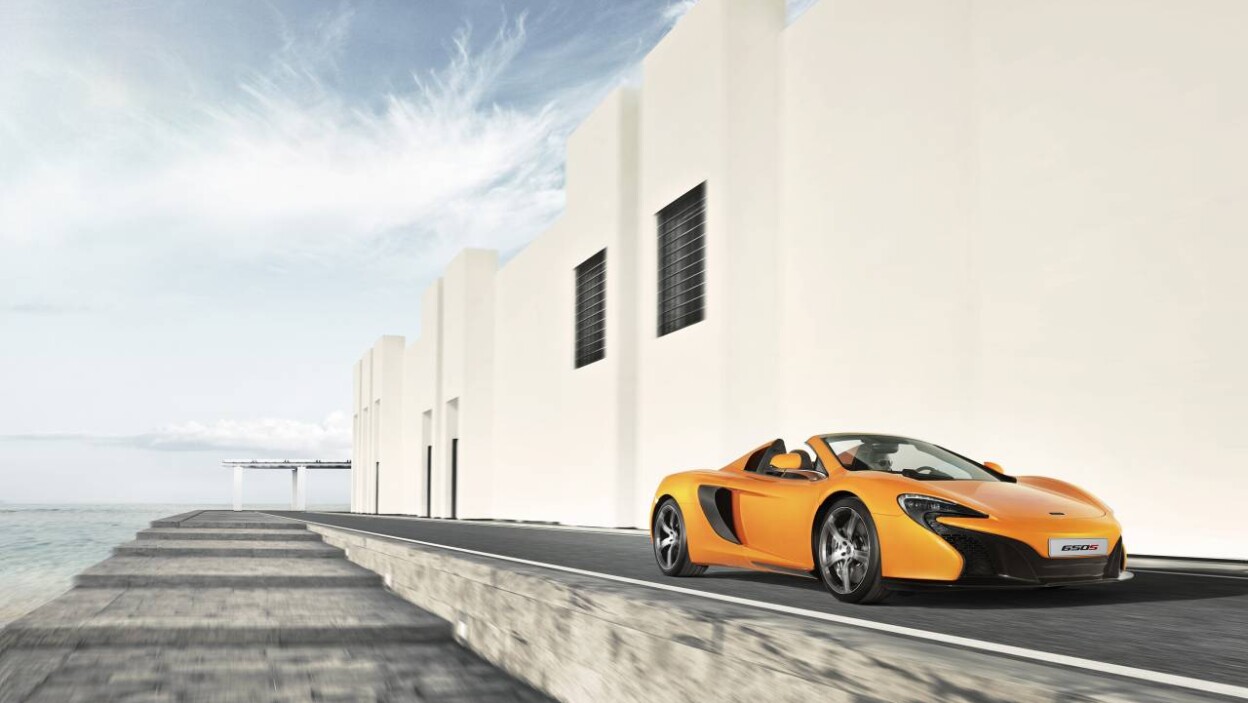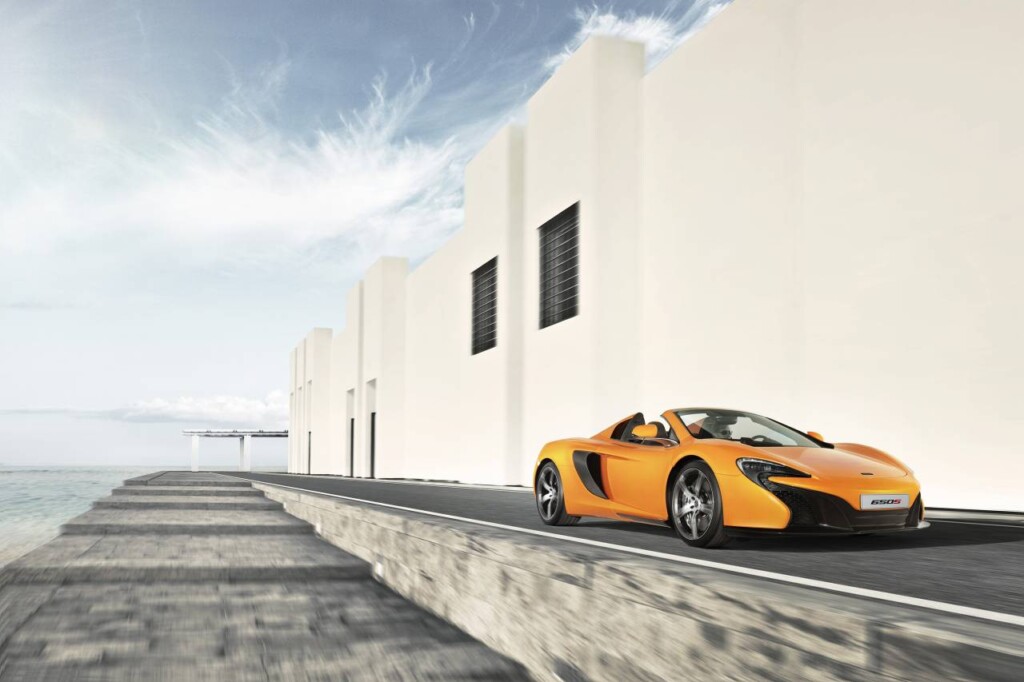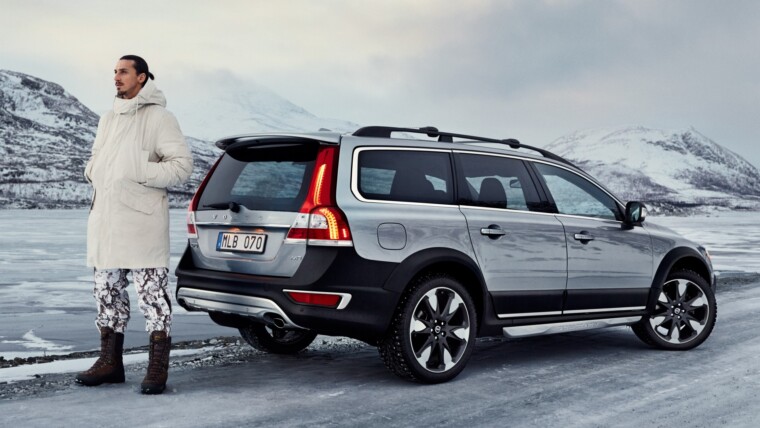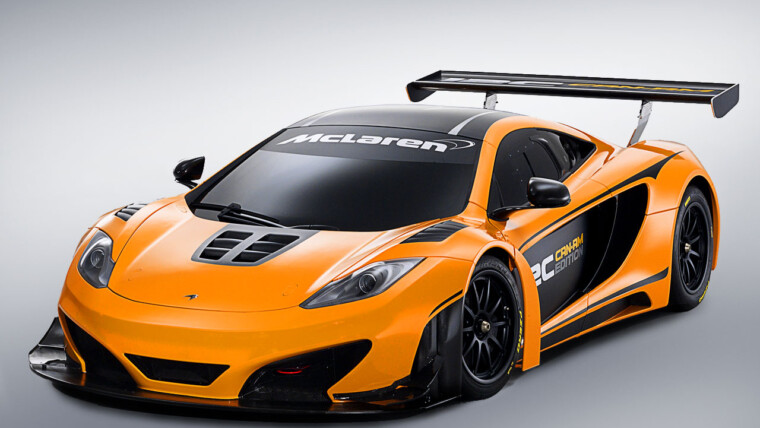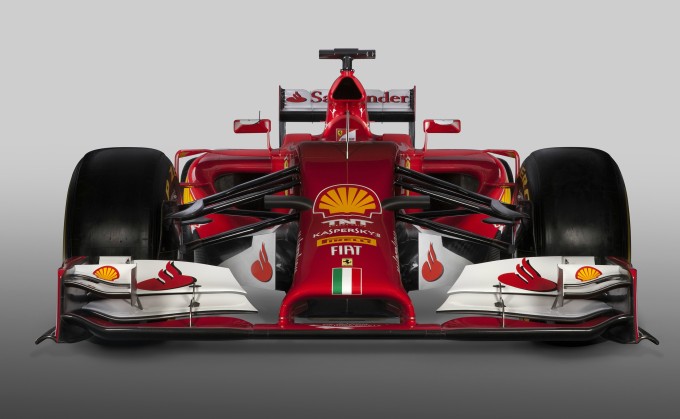McLaren Automotive has released to two videos following the reveal of the new McLaren 650S Coupé and 650S Spider at the 84th International Geneva Motor Show.
McLaren Automotive Chairman Ron Dennis and Chief Executive Officer Mike Flewitt were joined on the stand in Geneva by BBC Sport’s Formula 1™ presenter Lee McKenzie for the reveal of the latest model in the range. An edit of the press conference can be viewed at: http://bit.ly/1eXus6y.
A short film summarising the 50 years of McLaren, the race wins and motorsport know-how which have inspired and helped develop the new McLaren 650S is available to view and embed at: http://www.youtube.com/watch?v=0IYFW0IvXuQ. The 40 second edit shows a snapshot of more than 80 models through the history of McLaren, which have all led to the latest model.
The cars that have formed the history of McLaren, and help shape the McLaren 650S, are listed in more detail below.
Austin Ulster (1929)
Purchased by Bruce’s father in 1947 for $110. The experience Bruce gained from rebuilding and learning to drive this car launched him onto a carrier as both a racing driver, engineer and team leader.
M1A (1964)
Designed and built by Bruce and his small team at his factory in Feltham (UK), the M1A was constructed using a space frame chassis and powered initially by an Oldsmobile 3.9-litre V8. This car made its racing debut at the Mosport racetrack in Canada.
M1B (1965)
Re-engineered from the original M1A concept, the M1B was 20 percent stiffer, whilst maintaining the original weight. This was the official McLaren team car through the 1965 season.
M1B MkII (1966)
Customer car manufactured by Elva and supplied as a chassis only so that the customer could select an engine that suited their particular requirements from a choice of Oldsmobile, Ford or Chevrolet powerplants.
M2B (1966)
The first of what has become a long and successful line of Formula 1™ cars. Manufactured using ‘Mallite’, an innovative material of end cut balsa wood sandwiched between thin gauge aluminium. First ran at the Monaco Grand Prix and scored the fledging team three points over the four races it competed in through the year.
M3A (1966)
Built as a Formula Libre and hill climb car, made famous as the car driven by James Garner in the MGM movie Grand Prix. Constructed using a spaceframe design, the three chassis built proved very competitive and enjoyed a long working life in a variety of different formula.
M1C MkIII (1967)
The last of the Tubular spaceframe cars built by Elva as a McLaren customer car. A total of 25 chassis were built with most heading to North America to compete in the USRRC, as well as the higher profile Can-Am championship.
M4A (1967)
Designed to compete in the 1600cc Formula 2 or 1000cc Formula 3 championships, and built by Trojan. Also very popular in North America where it competed in Formula B.
M5A (1967)
A newly designed and built Formula1 car was ready for the 1967 season. Unfortunately, delays to the BRM V12 engine meant that it didn’t make its debut until the Canadian Grand Prix at Mosport
M6A (1967)
The third major design for the 1967 season, the M6A was the company’s first attempt at a monocoque Can-Am car. Using the lessons learned from the design and build of the M5A, and by early wind tunnel testing of the M1B, the team built three chassis. The M6A was a turning point in the fortunes of McLaren.
M6B (1968)
The customer version of the very successful M6A, Trojan built a total of 26 chassis, the bulk of which competed in the North American Can-Am series in privateers hands.
M7A (1968)
The car that bought McLaren’s first Grand Prix victory at the Belgium Grand Prix. Powered by the groundbreaking Ford DFV V8, that not only provided the drive to the rear wheels, but also became a structural part of the chassis. This helped reduce weight while maintaining stiffness and began a design trend that is still used today in modern Formula 1 cars.
M12 (1969)
A customer car built by Trojan. 15 examples were built, and competed in both the Can-Am and Group 7 race series.
M6GT (1969)
The M6GT was nothing less than a road legal version of the very successful M6A Can-Am race car, and could be viewed as Bruce’s personal testament to the vision of the company he had created. Only one example was built with a further two built as customer prototypes by Trojan. Bruce used his M6GT as a daily driver both to the office as well as local race meetings as he was keen to understand exactly what is was like as a road car. Unfortunately, the project was dropped after Bruce’s death.
M7C (1969)
The M7C chassis was re-designed as a full monocoque that the driver sat in rather than the bathtub design of the original M7A that the driver sat on. This update brought an increase in chassis stiffness as well as driver safety. Only one chassis was built that Bruce ran through the 1969 season.
M8B (1969)
Built as a successor to the successful M8A of the previous season, the M8B won all 11 Can-Am races during the 1969 season, including a record breaking eight 1-2 finishes. Hailed as the best racecar the McLaren factory had built to date, it was a period in time that saw the team achieve a peak of planning, preparation and performance.
M9A (1969)
With engine power output reaching beyond 400bhp, it was felt that the key to ensuring the best possible performance on the track was to develop a Formula 1 car with a 4WD system. A single M9A chassis was built and raced just once at the British Grand Prix. This technology was soon overtaken by the use of aerodynamics to increase downforce and tyre performance.
M8C (1970)
Built by Trojan as a customer variant of the all-conquering M8B, the M8C differed by using a supporting structure to house a variety of potential powerplants. 15 examples were constructed competing in North America and across Europe.
M8D (1979)
The M8D is inevitably remembered as the car in which Bruce died while testing at the Goodwood Circuit in the South of England. It ultimately gave the team another Can-Am championship winning season, with nine wins from 10 races during the year.
M10A (1970)
The McLaren-Trojan Formula A/Formula 5000 Chevrolet powered single-seater was designed to be a production car for both works and privateer teams. The design was based on the race winning M7A chassis from 1968 with an engine supporting structure to support the various 5-litre engines available.
M14A (1970)
Taking the successful design features from the M7A and M10A, a new car was developed for the 1970 Formula 1 season. The car achieved multiple podiums during its competitive life.
M15 (1970)
With all the success of the Can-Am series in North America, the decision to tackle another lucrative race opportunity was made and a new car designed. The M15 Indycar took design elements from successful elements of both Formula 1 and Can-Am racecars. Two cars where run with one finishing 9th and the other a DNF. It gave the team a taste of things to come with success at the famous Indy 500 only just around the corner.
M8E (1971)
With the success of the M8D through the 1970 season, privateers where lining up for the new McLaren-Trojan customer car for the start of the 1971 season. Powered by a Chevrolet 8-litre V8 allowing the engine to be used as a stress member in a customer car for the first time.
M8F (1971)
The last of the factory McLaren Can-Am cars to dominate through the season with Peter Revson taking the title from Denny Hulme in the sister car. Over the last four years of racing, a McLaren had achieved 32 wins out of 37 races, 19 of them in succession.
M16E (1975)
Developed for the Indy 500 with design elements of the M23 Formula 1 car. The M16E first ran in 1975 where it finished 2nd, and returned a year later to claim overall victory. It was the last McLaren Indycar to run with the American Offenhauser 4 cylinder turbo engine before the switch to a turbo Ford DFV V8 in 1977.
M18 (1971)
A successor to the successful M10A/B Formula 5000 racer. It had aerodynamic elements of the M16 Indycar through its wedge shape nose and was powered by a Chevrolet V8.
M8F/P (1972)
Customer version of the factory built M8F. 10 examples where built by Trojan and where virtually identical to the original works cars.
M16B (1972)
Success for McLaren at the Indy 500 was achieved with the M16B in 1972. Lapping at an average of 162.962mph for the entire race distance, and while it wasn’t one of the two factory cars competing that year, it was still a historic win for a car that had been inspired by Bruce McLaren just a few years previously.
M21 (1972)
After a four year absence from Formula 2, McLaren returned with the striking looking M21. Driven by up and coming South African driver, Jody Scheckter, it unfortunately didn’t achieve the success that it deserved and plans to build further chassis through 1973 were shelved.
M19C (1972)
A revised chassis and suspension design from the preceding M19A, the M19C scored regular podium points for the team with third-place finishes in Belgium and Italy. The car was used in the early part of 1973 whilst the M23 was being readied.
M23 (1973)
Designed to new regulations for the 1973 Formula 1 season, the M23 was one of the most outstanding designs of its era. Designed by Gordon Coppuck, it took a number of leads from the successful M16 Indycar he had designed over the previous seasons. It achieved pole position in its first Grand Prix in South Africa and through the season had three victories, and a number of points finishes to end the season third in the constructors championship.
M16D (1974)
Johnny Rutherford scored the second of three wins at the Indy 500 for McLaren in 1974, and the first for the works team. The M16D took advantage of the aerodynamic developments of the M23 Grand Prix car with new rear wing and cockpit surround smoothing airflow over the car.
M23 (1974)
The 1974 M23 was a development from the previous season and included a longer wheelbase, and wider track to improve weight distribution. The rear wing was also brought forward to comply with new aerodynamic regulations. With Emerson Fittipaldi at the wheel, the M23 won both the Drivers and McLaren’s first ever Formula 1 Constructors championship.
M25 (1974)
A single chassis was built as the last McLaren designed Formula 5000 racecar. It was derived from the Gordon Coppock designed M23 Formula 1 car.
M23 (1976)
The initial aerodynamic configuration at the start of the 1976 season saw the car run in a non championship event with a tall airbox. Regulation changes prior to the first race prompted a change to a low level split airbox.
M23 (1976)
A gripping season that ended with a showdown in the rain at Mount Fuji in Japan. James Hunt achieved the third place he required to beat Niki Lauda by a single point to claim the driver’s championship.
M26 (1977)
The M26 had been developed towards the end of the 1976 season in readiness for an assault on the 1977 championship. However, teething problems meant the M23 was only used for the opening four rounds of the season.
M24 (1977)
A new chassis was required for the Ford Turbo DVF V8 that had finally replaced the 40 year old Offenhauser engine in Indy racing. Gordon Coppock used the basic design of the M23 and created an Indycar that could not hide its Formula 1 ancestry. The car finished second in its first Indy 500 outing that year.
M28 (1978)
Designed to compete against the ground effect cars that had appeared the previous season, the M28 proved less effective than had been expected and with various developments through the year not bringing the performance gains required to improve performance.
M29 (1979)
Learning the lessons from the previous year, the M29 was lighter and more compact than its predecessor.
M30 (1980)
A number of aerodynamic developments, including some time in the full size MIRA wind tunnel, bought a small amount of progress to the team, but still not enough to be competitive. Only a single M30 chassis was constructed and this was crashed heavily at Watkins Glen and was not run again before the end of the season.
MP4/1 (1981)
“It was a big step into the unknown… like flying Concorde when you’ve only ever flown a Boeing 707” – John Watson’s famous quote relating to the pioneering carbon fibre MP4/1. This was the first fully carbon chassis to race in Formula 1 and went on to win the British Grand Prix at Silverstone that year. Designed by John Barnard and manufactured by Hercules in North America. It revolutionised the sport and brought about new levels of driver safety, and is arguably the most significant step forward in Formula 1 car design and construction.
MP4/1B (1982)
Considering the monumental changes between the M30 and the previous year’s MP4/1, the subtle changes to that resulted in the MP4/1B where relatively modest. The chassis was a little stiffer and lighter, and carbon disc brakes were used for the first time.
MP4/1C (1983)
Regulation changes outlawed the use of ground effect tunnel sections through the underside of the car and required all cars to run flat-bottomed chassis. However, that didn’t stop the MP4/1C from having a successful start to the season with an unexpected 1-2 at the Long Beach Grand Prix. Developments through the year included a change from the long serving Ford DFV, ran for the first time in the Grand Prix winning M7A in 1968, to a new TAG funded, Porsche-built turbo V6.
MP4/2 (1984)
The dominant car through the year with Lauda and Prost winning three quarters of the 16 races during the season between them. This dominance resulted in both the Driver’s and Constructor’s Championships for McLaren.
MP4/2B (1985)
A change of tyre manufacture and a redesigned turbo system gave the MP4/2B a decisive race pace advantage over its rivals. Prost won the Driver’s championship with 5 race wins and McLaren the Constructors Championship for the second season running.
48) MP4/2C (1986)
Small changes to the fuel tank size and a new 6-speed gearbox enabled the MP4/2C to maintain its advantage and McLaren took a third Driver’s Championship in a row.
MP4/3B (1987)
A single MP4/3 chassis used as a test bed for the incoming Honda V6 turbo for the 1988 season.
MP4/4 (1988)
Still the most successful Formula 1 car of all time. The low and sleek MP4/4 is considered by many to be the best-ever McLaren Formula 1 car. Designed by Steve Nichols and Gordon Murray, it won 15 out of the 16 races that year and bought a first Driver’s Championship to Ayrton Senna and the third Constructors Championship in four years.
MP4/4B (1988)
A development of the title winning MP4/4 chassis built to house the normally aspirated Honda V10 for testing duties.
MP4/5 (1989)
With the introduction of the 3.5-litre engine formula for 1989, there was a considerable amount of change to manage. A new monocoque, suspension system and an expected 700bhp out of the newly designed Honda V10 bought both the Driver’s and Constructor’s championships to Woking.
MP4/5B (1990)
Small developments to the previous year’s car in chassis material and gearbox design bought yet another Driver’s and Constructor’s Championship. Only the second time in history that a constructor had won the championship three times in a row.
MP4/5C (1990)
A development car, run through the winter of 1990 testing Honda’s new V12.
MP4/6 (1991)
Honda introduced a newly designed V12 featuring a greater piston area and therefore a higher potential rev limit to combat the progress being made at both Renault and Ferrari. The new engine was a success and another Driver’s and Constructor’s Championships was won.
MP4/7 (1992)
Late introduction of the revised Honda V12 meant that the testing time at the start of the season was reduced significantly. The team won races through the season and claimed second place in the Constructor’s Championship. Honda withdrew from Formula 1 at the end of the season.
MP4/8 (1993)
After agreeing a deal to secure Ford customer V8s for the 1993, the team developed the car through the season introducing a number of electronic driver aids such as active suspension and ABS braking. Senna scored a number of wins through the season with the most memorable being the European Grand Prix at a rain-drenched Donington Park.
MP4/8B (1993)
A development car built to test a Chrysler/Lamborghini V12 as a potential engine partner for the 1994 season. Tested by both Senna and Mika Häkkinen the feedback was generally positive, however, a deal was done with Peugeot for an engine supply for the 1994 season.
MP4/9 (1994)
Aerodynamically the MP4-9 had much in common with its predecessor with just subtle changes to the floor and sidepods. Internal upgrades included a clutch operated by steering column mounted paddle controls that enabled the drivers to left-foot brake, and power steering.
MP4/10 (1995)
A year that marked the beginning of, what would become, a very successful partnerships with Mercedes Benz as an engine supplier and Mobil 1 as a key technology partner. The MP4/10 was a completely new design that incorporated a high nose position enhancing the efficiency of the front wing.
MP4/11A (1996)
If the previous season was one of dramatic change, 1996 was to be a year of consolidation. Subtle changes to the suspension and a new longitudinal 6-speed gearbox were incorporated into the design and a new Phase 3 V10 producing over 700bhp and able to run up to 165000rpm was supplied by Mercedes Benz.
MP4/11C (1996)
A development car built to test the new maximum track width that had been mandated by the FIA in a bid to reduce cornering speeds.
MP4-12 (1997)
A new title sponsor and a new, highly regarded Technical Director, launched a new era for the McLaren-Mercedes team. The car was significantly changed from the previous year with a rear crumple zone and collapsible steering column required as part of the FIA’s new Formula 1 regulations. Claimed three race wins during the season. Brake Steer was introduced during the 1997 season, which now features on the current range of McLaren road cars, but was quickly banned as it was seen to offer a competitive advantage.
MP4- 98T (1998)
Designed as a two-seater marketing and promotional tool, the MP4-98T was executed with the trademark McLaren attention to detail and provided a unique opportunity for a lucky passenger to experience the power, acceleration, braking and cornering forces of a modern day Formula 1 car.
MP4-13 (1998)
The influence of Adrian Newey was almost immediate with the MP4-13 proving quick and reliable from the first day of testing. Over 12,000 man-hours had been spent through the winter exploring ways to regain the lost downforce due to the introduction of new aerodynamic regulations and new grooved tyres. The resulting Driver’s and Constructor’s Championship titles were the first since the days of Senna and Prost.
MP4-14 (1999)
The success of the MP4-13 through 1998 allowed the team to be more experimental with the design of the MP4-14. A new mid-height nose and high-sided bargeboards gave the car a much different look and the Mercedes V10 was now producing in excess of 785bhp. Häkkinen claimed a second Driver’s Championship while the team claimed second place in the Constructor’s Championship.
MP4-15 (2000)
An evolution of the MP4-14, changes were made to the aerodynamics and a new power-steering system was manufactured. The season was a closely fought battle with Ferrari with only a handful of points separating the two teams in both championships.
MP4-17A (2002)
Subtle differences in the suspension design to accommodate a new tyre manufacturer and new aerodynamic updates, delivered from the new wind tunnel that had come on stream at the teams new state-of-the-art headquarters in Woking, contributed to a solid start to the season. The enforced testing ban through August interrupted the development of the car and just a single victory was achieved.
MP4-T5 (2002)
A lesser-known McLaren success story is that of the 2002 MP4-T5 Soapbox Downhill Challenger, run at the annual Goodwood Festival of Speed. The project was run as a team building exercise and various space-age materials were used in its construction. The little racer fought off stiff competition from other manufactures and in doing so, set a new record course record of 65.1 seconds with McLaren Automotive Chief Test Driver, Chris Goodwin at the wheel.
MP4-17D (2003)
A heavily revised “D” version of the MP4-17A began the season whilst the much anticipated MP4-18A was being proven in testing. Perceived as an interim car, it raced the entire season being updated through the year with various technologies from the MP4-18A and finished third in the Constructor’s Championship.
MP4-18A (2003)
Keenly anticipated by the media yet destined never to race, the MP4-18A was a technological and aerodynamic step forward and provided a solid foundation of learning for the 2004 Championship contender.
MP4-19A (2004)
The family resemblance to the previous year’s unraced MP4-18A was unmistakable, yet under the sleek bodywork, the monocoque construction was in fact completely different allowing for a stiffer and stronger chassis without any additional weight penalty.
MP4-19B (2004)
A revised car was hurriedly made ready for the French Grand Prix at Magny-Cours. It had revised aerodynamics throughout, newly profiled side-pods and repositioned radiators. The main objective of these changes was to balance the temperature differential between the front and rear tyres, which had been an issue with the MP4-19A.
MP4-20A (2005)
The second generation of racecar that could trace it routes to the unraced MP4-18A, the MP4-20A looked decidedly different to the two versions raced in 2004 due to new aerodynamic regulations introduced by the FIA. McLaren won the most races during the year, but narrowly missed out on the Driver’s and Constructor’s Championships.
MP4-21A (2006)
The new season bought with it a new engine formula with the previous year’s 3-litre V10s making way for a smaller capacity V8. The MP4-21A was competitive but suffered from mechanical failures early in the season. The season ended with McLaren third in the Constructor’s Championship.
MP4-22A (2007)
The MP4-22A was launched in spectacular fashion in Valencia, Spain with two new drivers, Fernando Alonso and Lewis Hamilton and a new title sponsor. Results came quickly for the team with a double podium in Australia and a dominant 1-2 in Sepang. The rookie Hamilton then won back-to-back races in Canada and America to mark the most successful start to a Formula 1 driver’s career up to that point. The team finished second behind the Ferrari of Kimi Räikkönen.
MP4-23A (2008)
A substantial evolution from the MP4-22A, the MP4-23A had been in development for almost 10 months prior to the first race in Australia. Although the car looked visually similar to its predecessor, the aerodynamic and engineering upgrades that were rolled out through the season meant that by the time it sat on the grid in the final, thrilling race of 2008, it had its own unique look. Lewis Hamilton took the Driver’s Championship in dramatic fashion, with an overtaking move on the last corner of the last race of the year.
MP4-24A (2009)
With an unprecedented amount of change in the regulations governing the design and build of a Formula 1 car, the MP4-24A had a very different look from the previous generation of cars. Gone were the aerodynamic appendages and the car was fitted with a KERs system that recovered energy through the braking system ready to be released through the drivetrain at the push of a button on the steering wheel. The car achieved two wins through the season; the first in Singapore was the first for a Grand Prix car fitted with a KERS system.
MP4-25A (2010)
A radical aerodynamic overhaul and the removal of the KERs system for 2010 gave the MP4-25A and very different look to its predecessor. Designed around a ducting system which allowed the driver to stall the rear wing resulting in a reduction of drag and an increase in top speed. The car was very competitive through the season with two 1-2 finishes on the way to second place in the Constructor’s Championship.
MP4-27A (2012)
A more traditional looking car than the MP4-26A that proceeded it, the MP4-27A claimed victory and third place at the opening round of the season in Australia. The car won again through the later part of the season but too late to make an impact on the Championships.
MP4-28A (2013)
The MP4-28A faced a difficult debut in Australia with the team failing to get to grips with car’s lack of pace, but achieved second place in Sepang.
MP4-29A (2014)
Major new regulation introduce for 2014 have changed both the look and sound of the MP4-29A compared to the previous generation of Formula 1 cars. The normally aspirated 2.4 litre V8 has been replaced by a 1.6 litre turbo V6. New aerodynamic regulations covering the front and rear wing, as well as the nose position, come together to give the MP4-29A a sleek and purposeful look.
McLaren F1 XP5 (1993)
Only 65 road going examples of the McLaren F1 were built out of a total of 106, with XP5 being the last of five prototypes. Powered by a BMW 6.1 litre V12 that produced 627 horsepower, the McLaren F1 recorded a top speed of 243 mph (391 km/h) to claim the title of ‘fastest production car in the world’, and still holds the title of ‘fastest naturally aspirated car in the world’.
McLaren F1 GTR #01R (1995)
A number of requests were made asking for a racing version of the McLaren F1 to compete in the 1995 GT season. The racing version of the McLaren F1 that competed at the 24 Hours of Le Mans in the June that year was only slightly modified from the standard road-going version and the fact that the F1 GTR entered by Tokyo Clinic Team won the legendary classic at the first attempt underlined the integrity of the original design.
McLaren F1 GTR #014R (1996)
The second of two 1996 specification F1 GTRs bought to Japan to race in the All Japan race series, with the team claiming the title.
McLaren F1 LM XP1 (1996)
The McLaren F1 LM was born from the success of the GTR in 1995, and the lightweight, unrestricted limited edition was built in honour of the McLaren F1 GTRs that finished the 24 Hours of Le Mans. The one-off prototype, codenamed F1/XP1LM, is finished in the famous McLaren heritage ‘Papaya Orange’ of Bruce McLaren’s early Formula 1 and Can-Am racers.
McLaren F1 GT (1997)
Initially built as a single example solely for the purpose of homologating the 1997 McLaren F1 GTR Longtail racecar, two further orders were placed by existing McLaren F1 owners taking the total number of cars built to three. The new bodywork featured longer front and rear overhangs and a much higher specification interior than the original McLaren F1 roadcar.
McLaren F1 GTR (1997)
With more purpose built GT racecars taking to the track, it was clear that McLaren would have to raise its game if it wanted to be competitive through the 1997 season. The 1997 “Longtail” retained the production monocoque but had much longer front and rear overhangs generating considerably more downforce but with less drag.
12C (2011)
Groundbreaking first model launched by McLaren Automotive showcasing technology transfer from Formula 1 to the road. Featuring a carbon fibre MonoCell chassis and technologies such as Brake Steer and ProActive Chassis, the 12C redefined the high performance sports car market.
12C GT Can-Am Edition (2012)
Launched in 2012, the 12C GT Can-Am Edition is billed as the ‘ultimate track car’ from McLaren GT. The limited edition track-special is based on the highly successful 12C GT3 and pays tribute to the successes of Bruce McLaren and Denny Hulme in the Can-Am series through the 1960s and 70s.
12C Spider (2012)
Launched just one year after the 12C, the 12C Spider rewrote the rule book for convertible sports cars. With a carbon fibre chassis, no additional strengthening was required when the roof was removed, resulting in a no compromise high performance convertible.
McLaren P1™ (2013)
Limited to just 375 models, the next generation high performance sports car was designed to be the greatest driver’s car in the world on road and track. A combined power output of 916PS is produced by an efficient 3.8-litre V8 petrol engine and a lightweight, integrated electric motor.
Other posts by AF Newsdesk

